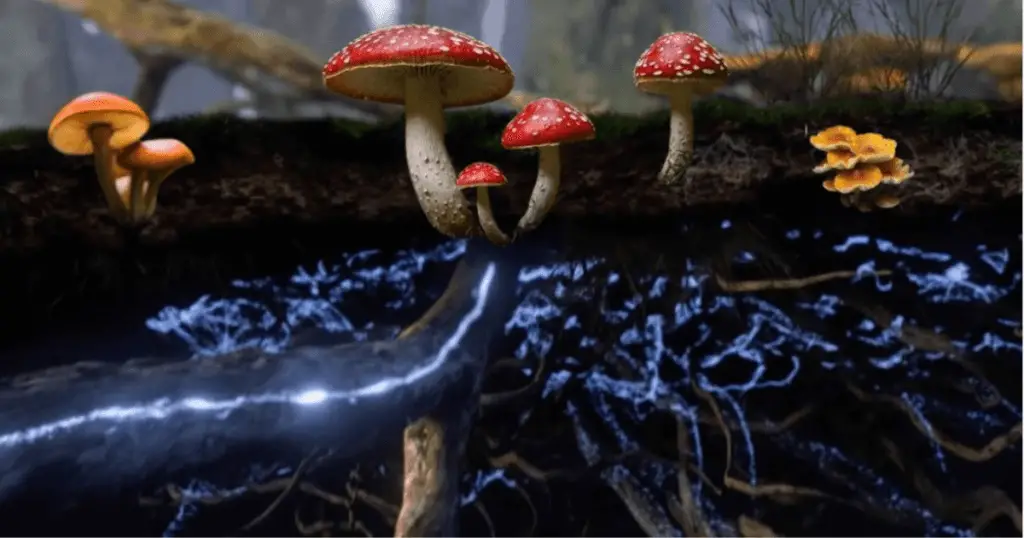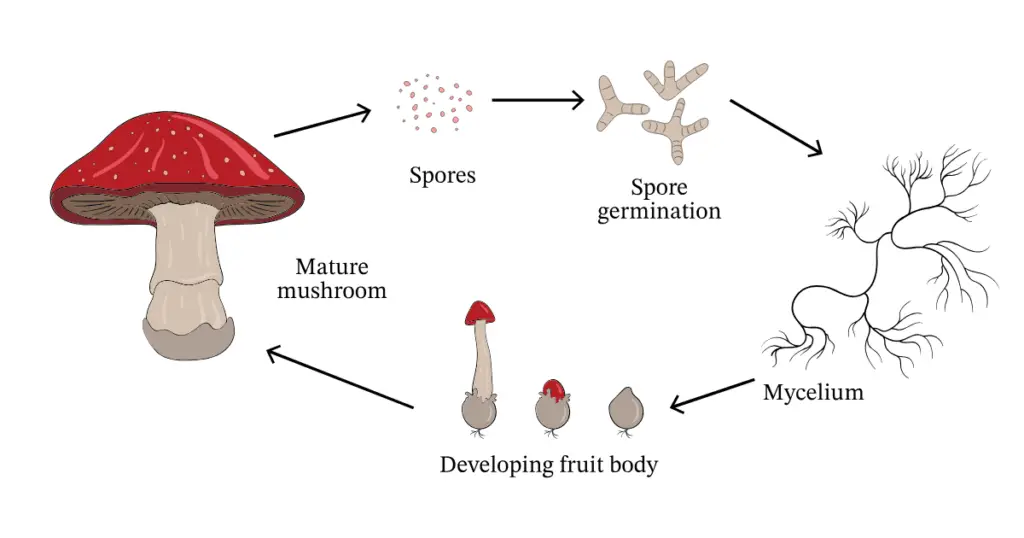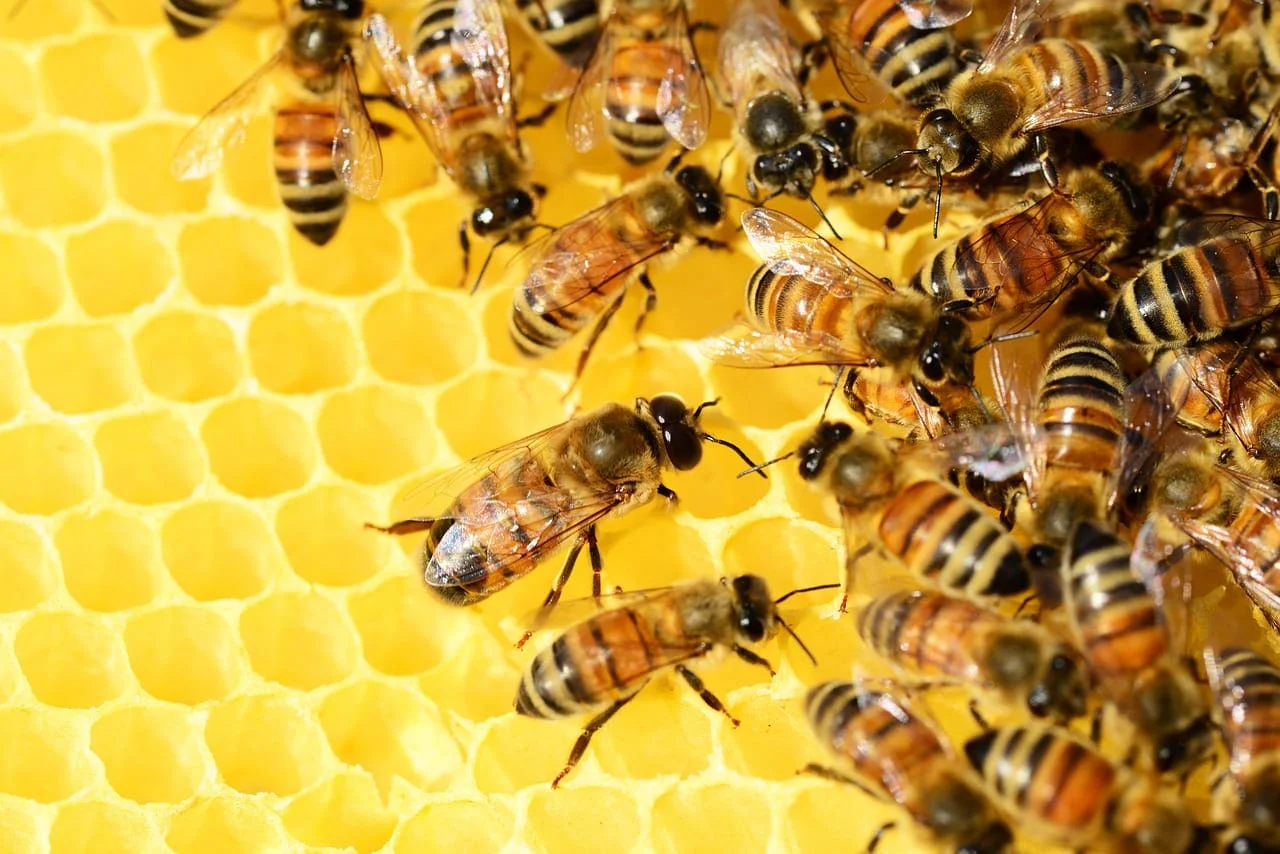The True Shape of a Mushroom – What Lies Beneath the Surface?
When you see a mushroom in the forest, you might think that’s all there is to it. A simple cap and stem growing from the ground. But in reality, what we all call a mushroom is just a temporary fruiting body. The essential part of a mushroom, the mycelium, is remains hidden from our eyes.

If you cultivate a mushroom in a petri dish on agar, its actual “shape” becomes visible. Mycelium, the true body of the mushroom, spreads like a vast web of fine, thread-like structures. This hidden network is what allows mushrooms to grow, reproduce, and even interact with their environment.
So, What Is Mycelium?

Mycelium is the vegetative body of a mushroom existing as a mass of branches, microscopic threads known as hyphae. These hyphae spread throughout the soil, wood, living and fallen trees, insects, and many other nutrient sources, absorbing nutrients and breaking down matter to support growth.
You can think of it, for instance, as Nature’s internet linking the forest together and facilitating the exchange of nutrients and information between trees and plants; moreover, it can even help weaker plants survive. Incredibly, up to 90% of land plants are connected to some form of mycelium network, which allows them to communicate, share resources, and support one another in ways that are still being uncovered by scientists. They call this vast fungal web the Wood Wide Web, and it plays a key role in keeping forests and ecosystems healthy.
But mycelium does more than just connect plants and trees, in fact, it is also nature’s best recycler. It has the amazing ability to break down harmful substances such as plastic, oil, and heavy metals, turning them into nutrients that help other organisms grow. This process, called bioremediation, is helping scientists clean polluted areas, restore damaged soil, and bring life back to struggling ecosystems.
How Do Mushroom Reproduce?

When the environment is right, the mycelium produces a fruiting body- the part we recognize as a mushroom. However, this fruiting body or the mushroom is temporary, lasting only a few days or weeks. Meanwhile, the mycelium stays hidden, living underground for years or even centuries!
Now, this fruiting body releases spores in to the thin air, allowing them to float around until they land in a suitable environment. If conditions are favorable, these spores germinate into hyphae, the tiny thread-like structures that begin the fungal life cycle. Hyphae eventually fuse together to form a network known as the mycelium. This mycelium then continues the cycle, eventually producing a new fruiting body- the mushroom- to start the process all over again.
How Big Can Mycelium Get?
You might be surprised to learn that the largest living organisms on Earth is actually a fungus!
In the United States, the giant fungus species name Armillaria ostoyae ( A honey mushroom) growing beneath the blue mountains of Oregon and it takes up approximately 2384 acres (965 Hectares) of land. Scientists believe this single fungal network has been growing for over 2,000 years, making it not only the largest but also one of the oldest living organisms on the planet.
Mycelium is not only big, it’s pretty much everywhere. Any land capable of supporting life will have a mycelial network, intricately woven into a dense mesh of unbelievably tiny threads. Scientists estimate that one teaspoon of healthy soil can contain up to 10 kilometers (6.2 miles) of hyphae- the microscopic filaments that form a vast, interconnected mass of mycelium.
Let that sink in. One. Freakin’. Teaspoon!
How Can We See Mycelium?
Since mycelium usually grows hidden within the substrate, it is not visible to the human eye. However, scientists and mushroom growers can observe its growth by cultivating it on an agar plate inside a petri dish.
Agar is a jelly-like substance that provides nutrients for the mycelium. When a small piece of mycelium is placed on agar, it spreads across the surface in a fascinating, web-like pattern. Each species of mushroom has a unique mycelium growth pattern, making it possible to identify different fungi based on their structure.
Why Is It Important to Understand Mycelium?
Mycelium is one of nature’s most fascinating and important organisms, yet it mostly goes unnoticed because it grows underground. By studying it, we can better understand how life on Earth works, how forests stay healthy, and how we can use mycelium to solve nowadays problems in sustainability, medicine, and environmental restoration.
Understanding the Hidden World Beneath Our Feet
Most people only notice mushrooms when they pop up on the forest floor or in their garden, however, we already know that’s just a small part of a much larger system. Mycelium is the real body of the fungus, serving as a vast, web-like structure that spreads beneath the soil, connecting plants, breaking down dead matter, and helping new life grow.
By growing mycelium in a petri dish, scientists and mushroom enthusiasts can see this hidden network in action. The way mycelium spreads and forms patterns reveals how it functions in the wild, helping us learn more about its role in nature. Each species of fungus has a different way of growing, and studying these patterns can help us identify different types of mushrooms, some of which have medicinal or environmental benefits.
Keeping Ecosystems Healthy
Forests rely on mycelium to stay strong. The tiny threads of mycelium form partnerships with tree roots to help trees absorb water and nutrients from the soil. In return, the trees provide the mycelium with food in the form of sugars. This relationship, called mycorrhizae, helps forests grow and survive, especially in tough conditions like droughts or poor soil.
Mycelium also connects trees and plants to one another. Some trees even use this fungal network to share nutrients with weaker trees, helping them survive. Scientists have even found that trees can send “warning signals” through mycelium, alerting their neighbors about insect attacks or disease threats.
Cleaning Up Pollution
One of the most exciting reasons to study mycelium is its ability to break down harmful substances. Mycelium is nature’s great recycler, able to digest dead plants, fallen trees, and even toxic materials like plastic, oil, and heavy metals. Instead of leaving waste in the environment, mycelium turns it into nutrients that help new life grow.
This process, called bioremediation, is being explored as a natural way to clean polluted land and water. Scientists are experimenting with using mycelium to absorb and neutralize oil spills, filter harmful chemicals from water, and restore damaged ecosystems. If perfected, this technique could become a powerful tool in fighting pollution and reversing environmental damage.
Mycelium in Medicine
Certain mushrooms, like Reishi, Turkey Tail, and Cordyceps, have been used in medicine for centuries, and scientists are now confirming their health benefits. Studies show that some types of mycelium can,
- Boost the immune system
- Support brain health and memory
- Reduce inflammation in the body
Because of these health benefits, they studying mycelium to develop new medicines and natural treatments for illnesses, including cancer and neurological diseases.
A Future Shaped by Mycelium
The more we learn about mycelium, the more possibilities we discover. Whether it’s keeping forests alive, cleaning up pollution, creating sustainable materials, or improving human health, mycelium is a hidden force shaping the world around us.
By growing it in a petri dish, you can see the unseen- a living, breathing network that has been working behind the scenes for millions of years. The next time you see a mushroom, whether in the forest or in your garden, just remember: what you see is just the tip of the iceberg. The real magic is happening underground!



